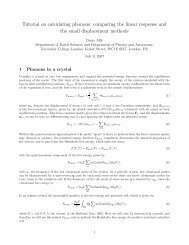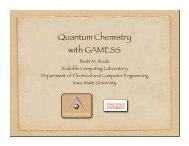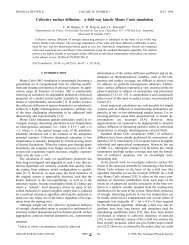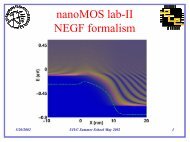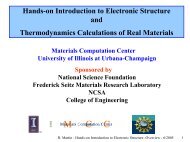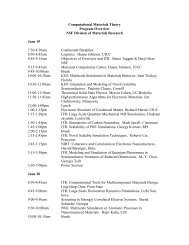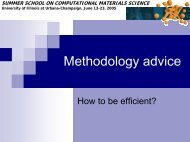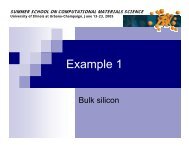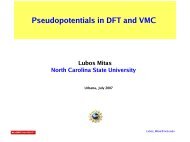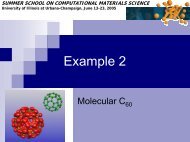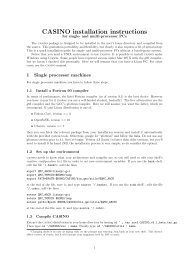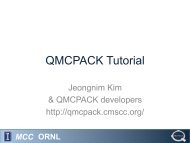Ab initio pseudopotential calculations of the orbital magnetization
Ab initio pseudopotential calculations of the orbital magnetization
Ab initio pseudopotential calculations of the orbital magnetization
Create successful ePaper yourself
Turn your PDF publications into a flip-book with our unique Google optimized e-Paper software.
<strong>Ab</strong> <strong>initio</strong> <strong>pseudopotential</strong><br />
<strong>calculations</strong> <strong>of</strong> <strong>the</strong> <strong>orbital</strong><br />
<strong>magnetization</strong><br />
Davide Ceresoli<br />
Present address:<br />
Department <strong>of</strong> Materials Science and Engineering<br />
MIT<br />
ES08 - 20 th Annual Workshop on Recent Developments in Electronic Structure Methods<br />
1
Francesco Mauri<br />
Ari Seitsonen<br />
Acknowledgments<br />
Institut de Minéralogie et Physique des Milieux Condensés (IMPMC)<br />
Université Pierre et Marie Curie, Paris, France<br />
Uwe Gerstmann<br />
IMPMC and University <strong>of</strong> Paderborn, Paderborn, Germany<br />
ES08 - 20 th Annual Workshop on Recent Developments in Electronic Structure Methods<br />
2
Outline<br />
● Modern Theory <strong>of</strong> <strong>the</strong> <strong>orbital</strong> <strong>magnetization</strong><br />
● Application: EPR g-tensor in molecules and solids<br />
● Orbital <strong>magnetization</strong> <strong>of</strong> Fe, Co and Ni<br />
● Conclusions<br />
ES08 - 20 th Annual Workshop on Recent Developments in Electronic Structure Methods<br />
3
Orbital <strong>magnetization</strong><br />
● Two contributions to <strong>the</strong> total <strong>magnetization</strong><br />
● Orbital <strong>magnetization</strong> usually small in solids ...<br />
S<br />
J<br />
L<br />
● ... but unquenched in nanostructures<br />
☞ Spin-Orbit interaction<br />
ES08 - 20 th Annual Workshop on Recent Developments in Electronic Structure Methods<br />
4
Spin-orbit<br />
Origin <strong>of</strong> M orb in solid and molecules<br />
Zeeman term<br />
● molecule radicals<br />
● paramagnetic defects in solids<br />
● ferromagnetic metals<br />
Schrekenbach and Ziegler, J. Phys. Chem. A 101, 3388 (1997)<br />
ES08 - 20 th Annual Workshop on Recent Developments in Electronic Structure Methods<br />
SO term<br />
spin-o<strong>the</strong>r-orbit (SOO)<br />
+<br />
relativistic mass<br />
corrections<br />
+<br />
...<br />
Atomic units,<br />
5
● Well defined in finite systems!<br />
Def<strong>initio</strong>n<br />
● Problems with periodic systems<br />
● position operator r incompatible with PBCs<br />
● surface currents<br />
� 1990's: Modern Theory <strong>of</strong> Polarization<br />
ES08 - 20 th Annual Workshop on Recent Developments in Electronic Structure Methods<br />
I surf<br />
6
Pass to Wannier functions<br />
Periodic systems<br />
Evaluate “Local Circulation” <strong>of</strong> <strong>the</strong> Wannier <strong>orbital</strong><br />
What about surfaces?<br />
ES08 - 20 th Annual Workshop on Recent Developments in Electronic Structure Methods<br />
7
Surface WFs<br />
Thonhauser, Ceresoli, Vanderbilt, Resta, PRL 95, 137205 (2005)<br />
Ceresoli, Thohauser, Vanderbilt, Resta, PRB 74, 024408 (2006)<br />
ES08 - 20 th Annual Workshop on Recent Developments in Electronic Structure Methods<br />
Each surface WF<br />
carries a net<br />
current!<br />
8
Periodic systems<br />
● Derived independently by two groups (2005-2006)<br />
Ceresoli, Resta, Thonhauser, Vanderbilt<br />
Xiao, Yao, Fang, Shi, Vignale, Niu<br />
● Valid for insulators and metals<br />
● Easy to implement in all-electron (AE) electronic structure<br />
codes<br />
● Extra terms for <strong>pseudopotential</strong>s (PS)<br />
ES08 - 20 th Annual Workshop on Recent Developments in Electronic Structure Methods<br />
9
GIPAW<br />
Origin <strong>of</strong> extra terms: NLPP's coupling to EM fields [1,2]<br />
Correct recipe: Gauge Including Projector Augmented Wave [3]<br />
● Gauge invariant, AE and PS eigenvalues coincide<br />
● Reconstruct <strong>the</strong> AE wvfcs from PS wvfcs<br />
● Based on <strong>the</strong> PAW method [4]<br />
[1] Ismail-Beigi, Chang and Louie, PRL 87, 087402 (2001)<br />
[2] Pickard and Mauri, PRL 91, 196401 (2003)<br />
[3] Pickard and Mauri, PRB 63, 245101 (2001)<br />
[4] Blöchl, PRB 50, 17953 (1994)<br />
ES08 - 20 th Annual Workshop on Recent Developments in Electronic Structure Methods<br />
10
Inner<br />
operator<br />
GIPAW transformation<br />
projector<br />
PS atomic<br />
ES08 - 20 th Annual Workshop on Recent Developments in Electronic Structure Methods<br />
AE atomic<br />
projector<br />
11
1.<br />
GIPAW reconstruction<br />
augmentation region<br />
2. 3.<br />
ES08 - 20 th Annual Workshop on Recent Developments in Electronic Structure Methods<br />
12
Orbital <strong>magnetization</strong><br />
ES08 - 20 th Annual Workshop on Recent Developments in Electronic Structure Methods<br />
All quantities calculated with PS<br />
hamiltonian and wavefunctions!<br />
13
Paramagnetic term<br />
Diamagnetic term<br />
Reconstruction terms<br />
same as in: Pickard and Mauri, PRL 88, 086403 (2002)<br />
ES08 - 20 th Annual Workshop on Recent Developments in Electronic Structure Methods<br />
14
EPR = Electron Paramagnetic Resonance<br />
Tipical fields ~0.5 T<br />
Resonance ~14 GHz<br />
EPR spectroscopy<br />
ES08 - 20 th Annual Workshop on Recent Developments in Electronic Structure Methods<br />
● Paramagnetic defects in solids<br />
● g-tensor and hyperfine couplings very<br />
sensitive to chemical environment<br />
15
For a spin 1/2<br />
The g factor is<br />
Connection to <strong>the</strong> <strong>orbital</strong> magn.<br />
2.002319...<br />
ES08 - 20 th Annual Workshop on Recent Developments in Electronic Structure Methods<br />
“chemical shift”<br />
Δg SO<br />
16
Calculation <strong>of</strong> <strong>the</strong> g-tensor<br />
● non perturbative method, SO interactions to all orders<br />
● 3 SCF <strong>calculations</strong> (j = 1..3) including SO<br />
● Δg SO directly from M orb<br />
ES08 - 20 th Annual Workshop on Recent Developments in Electronic Structure Methods<br />
17
Linear response (LR) method<br />
Linearizing Δg SO with respect to SO coupling strenght<br />
● SCF calculation (no SO included)<br />
● LR with respect to uniform B (3 pertubations)<br />
● Δg SO from induced current<br />
Pickard and Mauri, PRL 88, 086403 (2002)<br />
ES08 - 20 th Annual Workshop on Recent Developments in Electronic Structure Methods<br />
Current induced by<br />
uniform magnetic field<br />
18
● 8000 Å 3 Cubic supercell<br />
● 100 Ry PW cut<strong>of</strong>f<br />
● PBE functional<br />
● 2x2x2 k-points<br />
● Norm conserving PPs<br />
Technical details<br />
● 2 GIPAW projectors x angular momentum channel<br />
● du/dk computed as a covariant derivate<br />
ES08 - 20 th Annual Workshop on Recent Developments in Electronic Structure Methods<br />
19
Linear response<br />
● GIPAW linear response (LR) recently implemented in quantum-<br />
Espresso by Ceresoli, Seitsonen and Gerstmann<br />
● Available for production in Espresso-4.0<br />
● Capabilities<br />
� Magnetic susceptibility<br />
� NMR shielding tensors<br />
� Electric Field Gradients (EFGs)<br />
� EPR g-tensor<br />
� Hyperfine couplings<br />
� XAS (under development, S. Fabris and Y. Yao)<br />
� XANES (under development, G. Gougoussis and M. Calandra)<br />
References and codes:<br />
● www.gipaw.net<br />
● www.quantum-espresso.org<br />
ES08 - 20 th Annual Workshop on Recent Developments in Electronic Structure Methods<br />
20
Results for diatomic radicals<br />
ES08 - 20 th Annual Workshop on Recent Developments in Electronic Structure Methods<br />
● expt. data: solid matrix<br />
● values in ppm<br />
● SOO not included<br />
21
Results for molecule radicals<br />
ES08 - 20 th Annual Workshop on Recent Developments in Electronic Structure Methods<br />
● expt. data: solid matrix<br />
● values in ppm<br />
● SOO not included<br />
22
GIPAW corrections<br />
CN H 2 O +<br />
ΔM bare ~ 5-10 %<br />
ES08 - 20 th Annual Workshop on Recent Developments in Electronic Structure Methods<br />
1. Relativistic Mass Corrections<br />
23
Advantages over LR<br />
● need only SCF <strong>calculations</strong> → LDA+U, EXX, OEP, B3LYP, ...<br />
● no magnetic field<br />
● no symmetry restrictions<br />
● SO interaction to all orders<br />
Work in progress<br />
● benchmark against paramagnetic defects in solids<br />
● speedup<br />
● convergence w.r.t. k-points<br />
ES08 - 20 th Annual Workshop on Recent Developments in Electronic Structure Methods<br />
24
Orbital <strong>magnetization</strong> in ferromagnets<br />
ES08 - 20 th Annual Workshop on Recent Developments in Electronic Structure Methods<br />
25
Einstein only experiment!<br />
http://www.ptb.de/en/publikationen/jahresberichte/jb2005/nachrdjahres/s23e.html<br />
ES08 - 20 th Annual Workshop on Recent Developments in Electronic Structure Methods<br />
Einstein-de Haas effect<br />
The effect corresponds to <strong>the</strong> mechanical rotation that is<br />
induced in a ferromagnetic material (<strong>of</strong> cylindrical shape<br />
and originally at rest), suspended with <strong>the</strong> aid <strong>of</strong> a thin<br />
string inside a coil, on driving an impulse <strong>of</strong> electric<br />
current through <strong>the</strong> coil. To this mechanical rotation <strong>of</strong><br />
<strong>the</strong> ferromagnetic material (say, iron) is associated a<br />
mechanical angular momentum, which, by <strong>the</strong> law <strong>of</strong><br />
conservation <strong>of</strong> angular momentum, must be compensated<br />
by an equally large and oppositely directed angular<br />
momentum inside <strong>the</strong> ferromagnetic material.<br />
By measuring M tot and J tot you can<br />
extract S and L!<br />
26
Orbital <strong>magnetization</strong> in metals<br />
Which DFT is better for <strong>the</strong> <strong>orbital</strong> <strong>magnetization</strong>?<br />
Previous <strong>calculations</strong><br />
● LDA and GGA underestimate M orb [1,5]<br />
● better agreement with <strong>orbital</strong> polarization (OP) [2,3,4]<br />
● ... and CDFT [3,4]<br />
● [6] provides a link between CDFT and OP<br />
[1] Singh, Callaway, Wang, PRB 14, 1214 (1976)<br />
[2] Eriksson, Johanson, Albers, Boring, Brooks, PRB 42, 2707 (1990)<br />
[3] Ebert, Battocletti, Solid State Commun. 98, 785 (1996)<br />
[4] Ebert, Battocletti, Gross, Europhys. Lett. 40, 525 (1997)<br />
[5] Sharma, Pittalis, Kurth, Shallcross, Dewhurst, Gross, PRB 76, 100401 (2007)<br />
[6] Morbec, Capelle, Int. J. Quantum Chem., in press (2008)<br />
ES08 - 20 th Annual Workshop on Recent Developments in Electronic Structure Methods<br />
27
Results for Fe, Co and Ni<br />
This work: PBE, 90 Ry, up to 32x32x32 k-points<br />
[7] Meyer and Asch, J. Appl. Phys. 32, 330S (1961)<br />
ES08 - 20 th Annual Workshop on Recent Developments in Electronic Structure Methods<br />
all values in μ B<br />
28
k-points convergence<br />
ES08 - 20 th Annual Workshop on Recent Developments in Electronic Structure Methods<br />
Fe<br />
29
Contributions to <strong>the</strong> <strong>magnetization</strong><br />
ES08 - 20 th Annual Workshop on Recent Developments in Electronic Structure Methods<br />
all values in μ B<br />
30
Conclusions<br />
● Derived <strong>orbital</strong> <strong>magnetization</strong> formula for ab <strong>initio</strong><br />
<strong>pseudopotential</strong> <strong>calculations</strong><br />
● Non perturbative method to compute EPR g-tensor<br />
tested against small molecule radicals<br />
● We computed <strong>the</strong> <strong>orbital</strong> <strong>magnetization</strong> <strong>of</strong> Fe, Co and Ni<br />
● Work in progress<br />
- evaluate speedup with respect to linear response method<br />
- combine non perturbative EPR method and LDA+U<br />
ES08 - 20 th Annual Workshop on Recent Developments in Electronic Structure Methods<br />
31
● Coupling to NLPPs (ICL)<br />
● Coupling to NLPPs (Pickard-Mauri)<br />
● Effective spin hamiltonian<br />
● Spin-orbit<br />
Extra slides<br />
ES08 - 20 th Annual Workshop on Recent Developments in Electronic Structure Methods<br />
32
Non local <strong>pseudopotential</strong><br />
Magnetic field coupling to non local potentials<br />
r<br />
•<br />
R<br />
augmentation<br />
region<br />
r '<br />
● gauge invariant<br />
Ismail-Beigi, Chang and Louie, PRL 87, 087402 (2001)<br />
ES08 - 20 th Annual Workshop on Recent Developments in Electronic Structure Methods<br />
33
Non local <strong>pseudopotential</strong>s<br />
Magnetic field coupling to non local potentials<br />
r<br />
•<br />
R<br />
augmentation<br />
region<br />
r '<br />
Pickard and Mauri, PRL 91, 196401 (2003)<br />
● gauge invariant<br />
ES08 - 20 th Annual Workshop on Recent Developments in Electronic Structure Methods<br />
● same AE and PS eigenvalues<br />
34
Effective spin hamiltonian<br />
g tensor<br />
hyperfine<br />
couplings<br />
ES08 - 20 th Annual Workshop on Recent Developments in Electronic Structure Methods<br />
SOO + o<strong>the</strong>r relativistic<br />
Zero field<br />
splitting<br />
35
GIPAW<br />
Gauge Including Projector Augmented Wave [1]<br />
● Correct treatment <strong>of</strong> magnetic field coupling<br />
● Gauge invariant<br />
● AE and PS eigenvalues coincide<br />
● Based on <strong>the</strong> PAW formalism [2]<br />
● Yields accurate AE properties from PS wavefunctions<br />
[1] Pickard and Mauri, PRB 63, 245101 (2001)<br />
[2] Blöchl, PRB 50, 17953 (1994)<br />
ES08 - 20 th Annual Workshop on Recent Developments in Electronic Structure Methods<br />
36
● Norm conserving PPs<br />
Technical details<br />
● 90 Ry PW cut<strong>of</strong>f, 0.001 Ry cold smearing<br />
● PBE functional<br />
● 2 GIPAW projectors x angular momentum channel<br />
● du/dk computed via k·p method<br />
● up to 32x32x32 k-points<br />
● spin constrained along easy axis (Fe [100], Ni [111], Co [001])<br />
ES08 - 20 th Annual Workshop on Recent Developments in Electronic Structure Methods<br />
37
Periodic systems<br />
ES08 - 20 th Annual Workshop on Recent Developments in Electronic Structure Methods<br />
38




